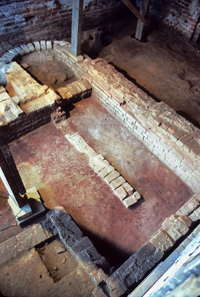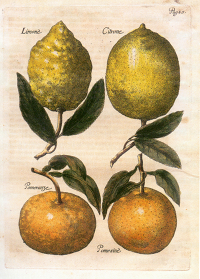THE CALVERT HOUSE
An Architectural Anomaly

In 1982, a puzzling archaeological discovery was made while excavating the Calvert House, the 18th-century Annapolis home of Maryland's colonial governors. Beneath the floor of a 1770s addition to the house, a peculiar set of brick channels was uncovered. The structure was a channel connected to a fireplace and was bright red from exposure to heat. It is called a hypocaust, and was probably used for heating a greenhouse used to grow semi-tropical plants and flowers. The discovery of this special architectural feature poses an intriguing question: Why was a 1720s heating system found in an early colonial town?
The Greenhouse
The hypocaust heating system was found only a few inches below a newer floor, and took nearly eight months to clear. Measuring 10 feet square and 1 ½ feet deep, the heating channel consisted of a barrel vault, an ash box, and a narrow, sloping runway. Ceramics found in association with the heating channel date it to the 1720s, a time when Charles Calvert served as governor of Maryland (1720-1727). Archaeology revealed that the greenhouse appears to have been destroyed by the 1770s. Thus, one is left with the question of why an early Governor of Maryland would have built such an elaborate structure to grow semi-tropical plants. Dr. Anne Yentsch, its excavator, needed more than what was in the ground alone to interpret this feature. She turned, instead, to historical records to more fully flesh out her interpretation of the heating channel and its importance.
Oranges and Ostentation

The unidentified relationship between semi-tropical plants and colonial Chesapeake society led Anne Yentsch to Enlightenment philosophy. Through a reading of 18th-century garden treatises and Enlightenment philosophy, she forged an important link between observation and control of the natural world with control of the political world. While we may never fully understand the importance of the Calvert orangery, the Calvert House investigations have suggested an interesting connection between landscaping and the 18th-century sociopolitical elite's quest for power.
While we may never fully understand Charles Calvert's true horticultural intentions, we have understood the importance of symbolic power seen in material culture. And, with the archaeological analysis of the Calvert orangery, we may have seen how unequal power is naturalized through means other than overt force.
Further Reading
Yentsch, Anne E.
1990 The Calvert Orangery in Annapolis, Maryland: A Horticultural Symbol of Power and Prestige in
an Early Eighteenth-Century Community. In Earth Patterns: Essays in Landscape Archaeology, edited
by William M. Kelso and Rachel Most, pp.169-188. The University Press of Virginia, Charlottesville.
1994 A Chesapeake Family and their Slaves. Cambridge University Press, Cambridge.
Yentsch, Anne E. and Larry McKee
1987 Footprints of Buildings in 18th Century Annapolis. American Archaeology 6:1:40-51.



